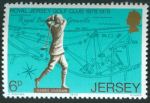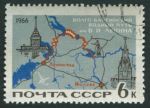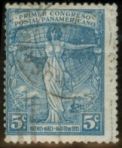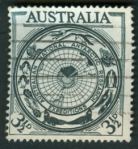
New Zealand, Scott 237, 1940, 37mm x 22mm
This lovely green and purple item depicts the route of the square-rigger SS Dunedin which carried the first shipment of frozen mutton from Port Chalmers, New Zealand to England on the 15th of February, 1882. Sailing across the south Pacific, she negotiated the passage around Cape Horn and the long voyage up the Atlantic to London, a total of 12030 (nautical?) miles, with its cargo refrigerated the whole time. (No word on what the cargo was for the long return voyage.) The continents are labeled boldly on the map, which has a frame celebrating the centennial of New Zealand in the year of issue.
Although the stamp celebrates peaceful commerce, it was issued at a time when the threat to merchant shipping was most perilous, with wolf packs of German U-Boats patrolling the sea lanes of the Atlantic. I can only imagine that the sender of a letter bearing this stamp would have had thoughts of the war in mind seeing this little image. And perhaps if that person were nautically-minded, thoughts might also have turned to the loss of the Dunedin less than a decade after this historic voyage, presumed wrecked on the rocks of Cape Horn.
This, to me, is a fine example of the idea I had when I gave this blog the name it has. Long stretches of time and huge expanses of the Earth combined with the big events of history, all are carried by a little bit of ink on a rectangle of perforated paper.


















